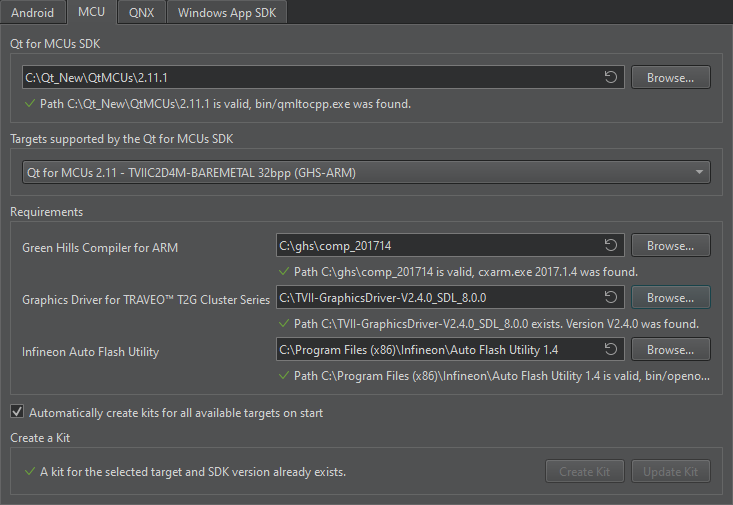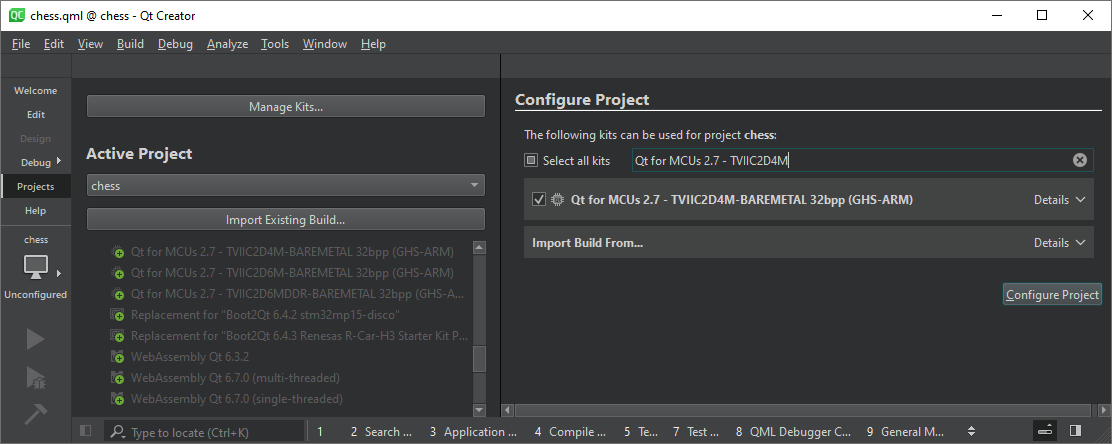C
Getting started on Infineon
This topic provides all the necessary information to get started on the Infineon platforms supported by Qt Quick Ultralite. Qt for MCUs is an Infineon Certified HMI Tool.
Note: Make sure you have all the prerequisites installed before setting up the development environment.
Setting up the development environment
Configuring the Qt Creator IDE
To develop for MCUs using the Qt Creator IDE, the MCU plugin is required. Qt Online Installer enables it by default when you install the Qt for MCUs SDK.
To build and run your application on MCUs, you must create a kit:
- Select Edit > Preferences > SDKs > MCU.
Note: If you cannot see the MCU tab, select Help > About Plugins, enable the Qt for MCUs plugin, and restart Qt Creator to apply changes.
- If not already set, provide the path to the Qt for MCUs installation directory.

- Select a Target supported by the Qt for MCUs SDK. For example, Qt for MCUs 2.12.0 - TVIIC2D4M-BAREMETAL 32bpp.
- In the Requirements section, ensure that the platform-specific requirements are met.
- Select Automatically create kits for all available targets on start to create kits automatically.
Note: You can also create/update kits manually using Create Kit and Update Kit.
- Select Apply and restart Qt Creator if you choose to create kits automatically.
Configuring CMake variables
You can also set up the development environment from the command prompt. For more information on how to use CMake with Qt Quick Ultralite when developing applications for Infineon boards, see CMake manual for Infineon boards.
Building applications with prebuilt Qt Quick Ultralite libraries
Building applications using Qt Creator IDE
- Open the CMake project file for the example you want to build.
- In the Configure Project window:
- Select the kit you created earlier. For example, Qt for MCUs 2.12.0 - TVIIC2D4M-BAREMETAL 32bpp.
- Select Configure Project.

Once the project is configured, select Run or press Ctrl+r on your keyboard to build and flash the binary to the target.
Note: Flashing using Qt Creator will only work with an OpenOCD compatible debug probe. For an example, Infineon KitProg3, typically found onboard, and MiniProg4 are OpenOCD compatible.
Building applications using the command prompt
You can also build and flash applications from the command prompt.
The supported Infineon boards and platforms, as in the target operating systems, are listed in the tables below.
| Board | Target board name |
|---|---|
| TRAVEO T2G CYT3DL (4M [216]) | tviic2d4m |
| TRAVEO T2G CYT3DL (4M LITE KIT) | tviic2d4mlite |
| TRAVEO T2G CYT4DN (6M [327-BGA-REF, 327-BGA-REV-B and 500-BGA]) | tviic2d6m |
| TRAVEO T2G CYT4DN (6M LITE KIT) | tviic2d6mlite |
| TRAVEO T2G CYT4EN (6M DDR [500-BGA]) | tviic2d6mddr |
Note: The revision for tviic2d6m can be selected using the QUL_TVIIC2D6M_BOARD_REVISION CMake configure option.
| Platform | Target platform name |
|---|---|
| Bare Metal | baremetal |
The examples below illustrate how to build the minimal example for tviic2d4m-baremetal, tviic2d4mlite-baremetal, or tviic2d6m-baremetal.
QUL_ROOT and QUL_TOOLS are used in the command line examples below as if they were set as environment variables. For example:
export QUL_ROOT=$HOME/Qt/QtMCUs/2.12.0 export QUL_TOOLS=$HOME/Qt/Tools/QtMCUs
set QUL_ROOT=C:\Qt\QtMCUs\2.12.0 set QUL_TOOLS=C:\Qt\Tools\QtMCUs
cd %QUL_ROOT%\examples\minimal mkdir build cd build cmake .. -G "Ninja" -DQUL_PLATFORM=tviic2d4m-baremetal -DCMAKE_BUILD_TYPE=MinSizeRel -DQul_ROOT=%QUL_ROOT% -DCMAKE_TOOLCHAIN_FILE=%QUL_ROOT%\lib\cmake\Qul\toolchain\ghs-arm.cmake -DQUL_TARGET_TOOLCHAIN_DIR=C:\ghs\comp_201714 -DQUL_BOARD_SDK_DIR=C:\TVII-GraphicsDriver -DINFINEON_AUTO_FLASH_UTILITY_DIR="C:\Program Files (x86)\Infineon\Auto Flash Utility 1.4" cmake --build .
cd %QUL_ROOT%\examples\minimal mkdir build cd build cmake .. -G "Ninja" -DQUL_PLATFORM=tviic2d4mlite-baremetal -DCMAKE_BUILD_TYPE=MinSizeRel -DQul_ROOT=%QUL_ROOT% -DCMAKE_TOOLCHAIN_FILE=%QUL_ROOT%\lib\cmake\Qul\toolchain\ghs-arm.cmake -DQUL_TARGET_TOOLCHAIN_DIR=C:\ghs\comp_201714 -DQUL_BOARD_SDK_DIR=C:\TVII-GraphicsDriver -DINFINEON_AUTO_FLASH_UTILITY_DIR="C:\Program Files (x86)\Infineon\Auto Flash Utility 1.4" cmake --build .
cd %QUL_ROOT%\examples\minimal mkdir build cd build cmake .. -G "Ninja" -DQUL_PLATFORM=tviic2d6m-baremetal -DCMAKE_BUILD_TYPE=MinSizeRel -DQul_ROOT=%QUL_ROOT% -DCMAKE_TOOLCHAIN_FILE=%QUL_ROOT%\lib\cmake\Qul\toolchain\ghs-arm.cmake -DQUL_TARGET_TOOLCHAIN_DIR=C:\ghs\comp_201714 -DQUL_BOARD_SDK_DIR=C:\TVII-GraphicsDriver -DINFINEON_AUTO_FLASH_UTILITY_DIR="C:\Program Files (x86)\Infineon\Auto Flash Utility 1.4" cmake --build .
Once you have successfully built the minimal example application, use one of the following commands to flash it:
Using an OpenOCD compatible probe:
Using the automatically generated flash target:
cmake --build . --target flash_minimal
For more information about flashing from the command-prompt, see Flashing instructions for Infineon boards.
Note: In order for the application to start up properly a suitable bootloader must be always present on the target system. Refer to the bootloader flashing instructions chapter for details.
Debugging using GDB
For debugging, GHS probe, J-Link Ultra+ probe, and Miniprog4 are recommended. For more information about other debuggers that might work, contact Infineon or the tool vendor.
Note: The GDB backtrace might be inaccurate or incomplete when using the Green Hills compiler.
Requirements
Debugging with GDB requires the GNU Arm GCC 12.3.rel1 Toolchain. It can be downloaded from GNU Arm Embedded Toolchain Downloads. Alternatively, the GNU ARM GCC toolchain can be installed with the Qt Online Installer.
If using ModusToolbox, use the GNU ARM GCC toolchain installed with the ModusToolbox Tools Package from the ModusToolbox Setup tool. After installation, it's by default located in C:\ModusToolbox\tools_3.4\gcc on Windows or /opt/Tools/ModusToolbox/tools_3.4/gcc on Linux.
Compilation
Make sure to use -DCMAKE_BUILD_TYPE=Debug when configuring, in order for the built executable to get the necessary DWARF2 debug table.
Starting the GDB server
Set the INFINEON_AUTO_FLASH_UTILITY_DIR environment variable
Set INFINEON_AUTO_FLASH_UTILITY_DIR as shown below, with the path adjusted to the correct location for your machine:
set INFINEON_AUTO_FLASH_UTILITY_DIR="C:\Program Files (x86)\Infineon\Auto Flash Utility 1.4"
Using an OpenOCD compatible probe:
With the OpenOCD compatible probe connected, execute the following command:
%INFINEON_AUTO_FLASH_UTILITY_DIR%\bin\openocd -s %INFINEON_AUTO_FLASH_UTILITY_DIR%\scripts -f interface/kitprog3.cfg -c "transport select swd" -f target/traveo2_c2d_4m.cfg
%INFINEON_AUTO_FLASH_UTILITY_DIR%\bin\openocd -s %INFINEON_AUTO_FLASH_UTILITY_DIR%\scripts -f interface/kitprog3.cfg -c "transport select swd" -f target/traveo2_c2d_4m.cfg
%INFINEON_AUTO_FLASH_UTILITY_DIR%\bin\openocd -s %INFINEON_AUTO_FLASH_UTILITY_DIR%\scripts -f interface/kitprog3.cfg -c "transport select swd" -f target/traveo2_6m.cfg
With the J-Link probe:
Connect the J-Link probe to the J-Tag socket on the board and execute the following command:
%INFINEON_AUTO_FLASH_UTILITY_DIR%\bin\openocd -s %INFINEON_AUTO_FLASH_UTILITY_DIR%\scripts -f interface/jlink.cfg -c "transport select swd" -f target/traveo2_c2d_4m.cfg
%INFINEON_AUTO_FLASH_UTILITY_DIR%\bin\openocd -s %INFINEON_AUTO_FLASH_UTILITY_DIR%\scripts -f interface/jlink.cfg -c "transport select swd" -f target/traveo2_c2d_4m.cfg
%INFINEON_AUTO_FLASH_UTILITY_DIR%\bin\openocd -s %INFINEON_AUTO_FLASH_UTILITY_DIR%\scripts -f interface/jlink.cfg -c "transport select swd" -f target/traveo2_6m.cfg
Cores available for debugging
OpenOCD is now connected to the MCU and is waiting for GDB connections. If you look into the terminal output, you will find several ports that you can connect to. The first is the CM0+ (Cortex-M0+) core, and the remaining are CM7 (Cortex-M7) cores (one on TRAVEO T2G CYT3DL and two on TRAVEO T2G CYT4DN ). When you connect to the GDB server using GDB, choose the port corresponding to the core you want to debug.
Qt for MCUs by default uses CM0+ for the bootloader, and the first CM7 core for the application.
Connecting with GDB
Now you can connect to the GDB server and step through instructions.
Set the ARMGCC_DIR environment variable
Set ARMGCC_DIR as shown below, with the path adjusted to the correct location for your machine:
set ARMGCC_DIR="C:\Qt\Tools\QtMCUs\arm_gcc_12_3_1\bin"
With the OpenOCD compatible probe:
%ARMGCC_DIR%\arm-none-eabi-gdb.exe C:/path/to/binary/application.elf -ex "target remote localhost:3334" (gdb) monitor reset (gdb) continue
With the J-Link probe:
Note: As these boards are based on ARM big.LITTLE CPU architecture, make sure you use the monitor traveo2 reset_halt command to restart.
%ARMGCC_DIR%\arm-none-eabi-gdb.exe C:/path/to/binary/application.elf -ex "target remote localhost:3334" (gdb) monitor traveo2 reset_halt sysresetreq (gdb) continue
Board-specific information
The currently supported Infineon targets are listed below. For more information on all the targets supported by Qt Quick Ultralite, see Supported target boards and development hosts.
| Hardware | Board | Compiler | Operating System(s) |
|---|---|---|---|
| TRAVEO T2G | TRAVEO T2G CYT3DL (4M 216), CYT3DL (4M LITE KIT), CYT4DN (6M 327), CYT4DN (6M LITE KIT) and CYT4EN (6M DDR) | IAR Functional Safety Build Tools for Arm V8.22.3 and Green Hills MULTI Compiler for Embedded ARM 2017.1.4 | Bare Metal |
| TRAVEO T2G | TRAVEO T2G CYT4DN (6M LITE KIT) | GNU Arm GCC 11.3.1 | Bare Metal |
Available under certain Qt licenses.
Find out more.

